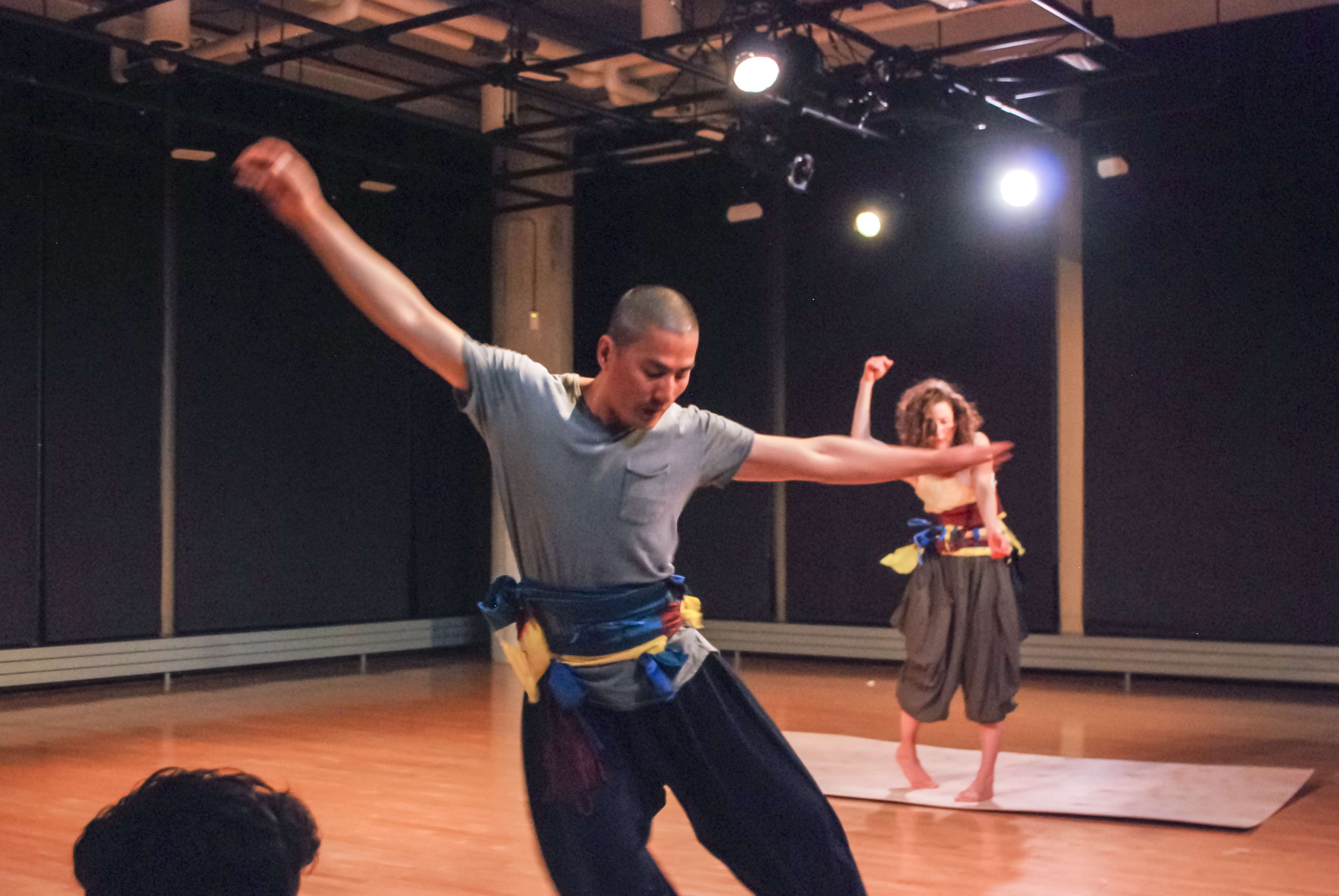Jungwoong Kim and Marion Ramirez perform in the Esch-Hurvis room.
Photo by Angelica Hurtado.
For the final event in Lawrence’s 2016-17 Dance Series, accomplished dancers Marion Ramirez and Jungwoong Kim performed a dance program featuring SaltSoul on Wednesday, April 12 at 8 p.m. in the Warch Campus Center’s Esch-Hurvis room. The couple has studied and performed SaltSoul, an expressive dance pioneered by Kim, extensively. SaltSoul is defined as “an exploration—through dance, voice, traditional music, and experimental video—of experiencing the sudden loss of a loved one, and how art evokes human capacity to address tragedy” in the explanatory pamphlet from the Asian Arts Initiative handed out by the artists at the end of the show. Ramirez and Kim’s performance certainly embodied all of these aspects.
Walking into Esch-Hurvis that Wednesday night, I—and presumably many others in attendance— knew nothing about Ramirez and Kim, how they danced together, what their performance would involve or what SaltSoul was. Ramirez and Kim obviously wanted audience members to maintain this uninformed, unadulterated view of their performance, since they did not explain what SaltSoul was until the conclusion of the program.
Although chairs were set up in a U-shape facing the center of the room, guests were encouraged to sit on the floor in front of the chairs. Accordingly, I sat on the floor in the middle of the room and began to observe the performance, which started as soon as the ushers opened the doors to the room. Everything was dark except for a single spotlight on Ramirez, in the center of the room, kneeling in front of a low wooden-plank table loaded with random objects. As audience members seated themselves, Ramirez stroked the objects on the table, drawing attention to certain ones, and showing how sand spread around the objects by moving it around with her fingers. A soundtrack of muted voices and distant storm sounds enveloped the space as the table and its objects began to tremble when, suddenly, the table flipped up and towards the audience, scattering all of the objects in the room with an enormous crash. Some audience members gasped and jumped back; even Ramirez had jumped away from the table, which turned out to not be more than just a table, since underneath it lay Kim, eyes closed and trembling.
After awaking from his apparent nightmare, Kim rose and began to interact with Ramirez. The expressions on both of their faces were in tune with the movements their bodies, achieving sublime cohesion of movement. Sometimes, they would barely move at all, or they would move with such slowness and deliberation that I could feel the power in their motion. Almost all of their performance involved expressions of obvious pain. At some point in the program, it occurred to me to look down at my pamphlet, which is where I read the brief notes that explained that their program had to do with SaltSoul, and that SaltSoul was about grief. Once I knew this, my entire view of Ramirez and Kim’s movements changed; suddenly, everything they did was more meaningful.
Ramirez and Kim ended up working with two wooden planks, around the same size, for much of their performance, and one of the most moving portions of their illustration happened when they set up the two planks against each other like a wall. Kim stood on one side of the wall and Ramirez stood on the other, and the two began to talk to each other, saying a few words in a foreign language. After a time, Kim stopped answering Ramirez, and the silence that followed her repeated, unanswered inquiries was absolutely heartbreaking.
For the last section of their performance, Kim and Ramirez set up their two wooden planks in the shape of a T and projected, with two small devices, two short videos on each side of the T. Sitting in the middle of the room, I had a unique vantage and was able to see most of what was going on in each video. It struck me as interesting that the two videos, though they showcased approximately the same material, were not the same. For a few minutes, the videos showed footage of a view from a boat deck as well as footage of random cars and people walking along a street and different 9/11 memorials in New York City, among other things.
Once the performance concluded to heartfelt applause, Kim and Ramirez passed out their pamphlets on SaltSoul and held a question-and-answer session with the audience. During this session, the two explained their personal history working with SaltSoul and the reasons why they included certain elements of it in their performance. Kim revealed that his father passed away when he was 10 years old and that the resulting grief from that experience helped inspire him to develop his SaltSoul style. More specifically related to their performance, Kim and Ramirez wanted to commemorate and illustrate the recent tragedy that occurred when a Korean ferry sank and resulted in the drowning of several students. They explained that the wall set-up in that portion of the show was meant to illustrate what happened to one student on the ferry who was trapped in their room and kept communicating with another student—who survived—on the other side of a wall until they could no longer.
Ramirez and Kim’s performance was incredibly thoughtful and touching, and it did not resonate with me as much at the time as it did several days afterward. Even now, I keep recalling special details of their performance and remembering them with satisfaction and awe. Such meaningful performances can be hard to come by, so I am incredibly grateful for Ramirez and Kim’s visit to Lawrence and for the hard work and creativity that they poured into their performance.

